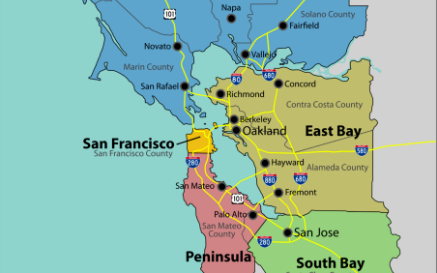As the number of COVID-19 cases in the US continues to rise at an unprecedented rate, schools across the country have had to temporarily close their doors. This means that thousands of classrooms have to rapidly transform from in-person to online, commonly referred to as distance learning. Schools around the Bay Area are taking different approaches to distance learning; as the crisis evolves, many schools are altering their distance learning plans, after having thought through their initial approaches, and have taken additional time to plan.
Schools, including University High School, Urban High School, and Notre Dame High School, are hosting synchronous classes on normal or modified schedules through meeting platforms like Zoom. This allows students to remain on a more regular schedule as they tackle school work from home.
“Some classes have been a little rough,” said Bella Ailanjian, a junior at Notre Dame High School, “since I’m staring at my screen for an hour and fifteen minutes while the teacher is just lecturing.”
Ailanjian, as well as Madison Kiss, a junior at Sacred Heart Cathedral Preparatory, both said they were initially frustrated by the amount of work they were assigned. They felt as though they were spending hours more on academics than they would during a normal week. Kiss thinks that her teachers were trying to respond as best they could, but were simply unaware of how time-consuming work could be online.
“The first couple of weeks were very difficult, but now going into our third week it’s been a little easier,” Kiss said. Both Notre Dame and Sacred Heart Cathedral Preparatory adjusted their response and changed teacher guidelines based on student feedback.
Ainsley Rodio, a junior at San Mateo High School (SMHS), said teachers are assigning her weekly work through an existing online portal. Burlingame High School and the San Francisco Unifed School District (SFUSD) have opted for a similar approach, relying on sites like Google Classroom and Canvas to distribute work.
Students at both SMHS and Burlingame High School (BHS) are receiving work from all their teachers regularly and are able to contact them during office hours. Grades are currently frozen to refect a student’s standing at the end of the Third Quarter. SFUSD has not been as quick to respond and switch to distance learning. Sebastian Lee, a student at The Academy High School, and SFUSD school in San Francisco said “right now, interaction with teachers has been very sporadic, sometimes they’ll post an assignment, sometimes they won’t.”
SFUSD has given teachers and schools until April 13 to finalize distance learning plans, so for now responses vary, teacher by teacher. Lee has been getting regular online discussion assignments from his history teacher but has not heard from his physics teacher at all. All work assigned to students in SFUSD High Schools is currently optional.
Many public schools around the Bay Area do not require their students to have computers at home during the regular school year, instead assigning work on paper. If a teacher assigns work on the computer in-class, students are able to use one of the school’s computers.
“Most of my online work [before the shutdown] would be in IB classes or higher level classes, but most regular classes are not online at all,” said Amelia Ghilzai, a senior at Sequoia High School in Redwood City.
For students to be able to participate in video calls or even turning in assignments, computers and WiFi are needed. The majority of schools in the Bay Area are lending computers or Chromebooks to students who do not have computers and either providing a hotspot or temporary WiFi to the student’s family.
“I was surprised they had those resources for everyone,” Ghilzai said. Aspen Morris, a junior at San Rafael High School, said that her school communicated their plan for lending Chromebooks and WiFi several days before the shutdown so all students who needed them were able to get them.
Even after distributing computers and WiFi to those who needed them, SMHS chose not to hold video calls as many students do not have the proper space in their homes to be on a call. Other schools are still choosing to hold video calls, but try to make them as short as possible, leaving the remainder of the class period for independent work.
The Oakland Unifed School District (OUSD) is still working on plans to distribute computers and Chromebooks. Their original plan was to work with the tech start up Tech Exchange to lend computers to students in need during spring break. However, with the state-wide shutdown, Tech Exchange had to close its doors until April 7.
OUSD plans to resume classes April 9, yet many students still do not have computers to use. Families have to reach out to Tech Exchange directly for computers and hotspots. Tech Exchange then provides a form to assess whether the family will receive a reduced-price computer or are eligible for a free computer.
It is unclear whether Tech Exchange will have enough resources for all of the families in the Oakland school district. Comcast is providing free WiFi for low income families for 60 days.
To alleviate some of the school-related stress students are feeling while also grappling with coronavirus, high schools and colleges around the country are opting for pass-fail classes. Many believe that shifting to a pass-fail grading system would be more equitable as each student is in a different position. Some students have taken on roles of caregivers for their younger siblings and others may not have the same access to resources they need to complete their work.
“The point of public school is to equalize people’s educational opportunities at school, and if they can’t do that it will be harder for some people to get good grades,” said Melia Oliver, a senior at Albany High School (AHS).
AHS is in the process of deciding how they will handle grading for the rest of the semester. There are currently two proposals: have the third quarter grades act as final grades or go to a pass-fail system.
The argument against pass-fail grades is that both colleges and graduate schools take grades into consideration during the application process. Students who may have struggled academically their freshman year, will no longer have the opportunity to show their growth with improved grades.
The majority of high schools around the Bay, including LWHS, have not made official statements on how they will proceed with grading.
These same conversations are being held in colleges around the country. Some colleges — such as UCLA —are allowing students to choose whether they want to receive a grade for their courses. Other colleges are completely pass-fail — such as Stanford and UC Berkeley.
Student movements at colleges are calling for “universal pass” or “A’s for all” to ensure that all students pass this year under these unusual circumstances.
The high school juniors interviewed for this article were concerned about how the upcoming college application process will be impacted by COVID-19 precautions. Both the March and May SAT dates have been cancelled, and ACT rescheduled their April test for June. Opportunities to take standardized tests are already limited and can take months to study for; recent cancellations put additional stress on students applying to college.
Rodio was preparing to take the SAT on March 20. Now, she thinks she may have to wait until August—the delay has thrown a wrench in her carefully thoughout testing schedule. Uncertainty surrounding SAT Subject Tests, the SAT and her grades have added heavy, unforeseen layers of stress to her second semester.
“I’m just not sure if I can find another time to take these tests,” Rodio said. “It’s really overwhelming, trying to find time to fit everything in.”
On April 1, the University of California system announced it would be test-optional for the Class of 2021. Tufts University, Boston University and other colleges followed suit; it’s suspected many other private institutions will, too. But these announcements haven’t eased much of current juniors’ stress.
The College Board has also modified Advance Placement (AP) tests to ft coronavirus social distancing restrictions. Instead of a formal, three-hour test, this spring’s exams will be an online, open-note 45 minute test. Students said this has thrown many of their AP courses completely of-track, as teachers try to adjust their curriculum and teaching methods to the updated exams.
Ailanjian is also concerned about how her SAT and AP tests and application process will be constrained due to COVID-19.
“I get it, it’s hurting everyone,” she said. “But it feels like juniors are really screwed over.”
Kiss was trying to get recruited for lacrosse to a Division II or III school. She had been talking to college coaches and scouts, who had vowed to come to her school games and club tournaments. But, now that both seasons are cancelled, Kiss doesn’t know how to continue through the recruitment process.
“I’m not really sure where that leaves me now,” she said.
Most of the students interviewed said they are still in contact with their college counselors. But their help is limited to an email or Zoom call; all college tours and admitted students days have been cancelled. This is especially a problem for seniors, as many have to choose their college based only on virtual tours and online info sessions.
As of April 8, SFUSD and OUSD have announced that the school sites will not reopen this school year; what distance learning looks like will continue to change in the coming months. With school closed for the foreseeable future, Ailanjian said she’s trying to remain optimistic. “Everyone is trying to stay upbeat but morale is definitely low,” she said. Kiss agreed: “People are just keeping their hopes up that we get to go back to school.”







